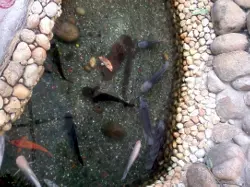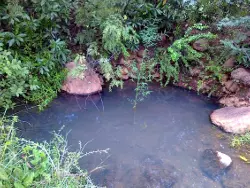Maintaining a Small Pond
The key to any healthy pond is maintenance. Wildlife and aquatic plants will flourish if you have the correct balance between plants and oxygen in the water. When it comes to pond maintenance there are a series of things to consider from pond pumps and filters through to ensuring your plant coverage is at an optimal level.
Some small ponds have pond pumps which are widely available from online stores such as Swell UK, whereas others do not require them at all. Pond pump maintenance can make a big difference in the overall water quality of your pond. If the pond pump is running slower than usual or has completely stopped it may be because the pump has gotten full of blanket weed. Blanket weed can be a really bad problem for ponds, so getting in the habit of manually pulling out the weed is also a good idea. Pond pumps are relatively easy to take apart, and if the inside appears to be covered in green, then it is blanket weed. If however this is ok it may be that something has got stuck in the impeller (where the water is sucked into the pump). Taking a screwdriver, it is easy to free any debris within the impeller. If you do regular maintenance on the pond as a whole by removing blanket weed and any dead leaves; the level of maintenance needed on your pond pump should be kept to a minimum.
 Small ponds require a full clean every couple of years. This is best done in the autumn as most of the wildlife is less active or is beginning to hibernate. Firstly you need to create a holding tank for any fish and deep water plants such as water lilies. Marginal plants should be fine as long as they are kept moist. The pond needs to be carefully drained and the fish and plants collected as they become visible. Any decaying plant material may contain small creatures so it is best to place them to one side to allow them to get back to the pond once you are finished. The next step is to clean the liner using a brush to remove any build-up of silt. To refill the pond use clean water; the best is rainwater from a water butt, and then carefully replace any plants and fish. It may take a short while for the pond to recover from being fully cleaned which is the reason cleaning in autumn is generally preferred.
Small ponds require a full clean every couple of years. This is best done in the autumn as most of the wildlife is less active or is beginning to hibernate. Firstly you need to create a holding tank for any fish and deep water plants such as water lilies. Marginal plants should be fine as long as they are kept moist. The pond needs to be carefully drained and the fish and plants collected as they become visible. Any decaying plant material may contain small creatures so it is best to place them to one side to allow them to get back to the pond once you are finished. The next step is to clean the liner using a brush to remove any build-up of silt. To refill the pond use clean water; the best is rainwater from a water butt, and then carefully replace any plants and fish. It may take a short while for the pond to recover from being fully cleaned which is the reason cleaning in autumn is generally preferred.
 One of the ways to keep maintenance to a minimum in a small pond is too ensure the correct location and coverage of plants. Small ponds will collect a lot of leaves if they are placed under deciduous trees, and will also collect silt and sediment if they are located at the lowest part of a garden. If these areas are avoided the level of maintenance is significantly reduced. Maintaining a healthy level of plant coverage in and around your pond is also important. Ponds should have enough coverage to stop algae growing but not too much to prevent sunlight from getting to the water. Marginal plants such as reeds and grasses are great for creating shade without creating leaf matter that will require clearing from the pond.
One of the ways to keep maintenance to a minimum in a small pond is too ensure the correct location and coverage of plants. Small ponds will collect a lot of leaves if they are placed under deciduous trees, and will also collect silt and sediment if they are located at the lowest part of a garden. If these areas are avoided the level of maintenance is significantly reduced. Maintaining a healthy level of plant coverage in and around your pond is also important. Ponds should have enough coverage to stop algae growing but not too much to prevent sunlight from getting to the water. Marginal plants such as reeds and grasses are great for creating shade without creating leaf matter that will require clearing from the pond.
Ponds are a fantastic addition to any garden, and they do not need to be limited by the size of the space you have for them. Careful maintenance and suitable placement can make small ponds exceptionally easy to look after.
Some small ponds have pond pumps which are widely available from online stores such as Swell UK, whereas others do not require them at all. Pond pump maintenance can make a big difference in the overall water quality of your pond. If the pond pump is running slower than usual or has completely stopped it may be because the pump has gotten full of blanket weed. Blanket weed can be a really bad problem for ponds, so getting in the habit of manually pulling out the weed is also a good idea. Pond pumps are relatively easy to take apart, and if the inside appears to be covered in green, then it is blanket weed. If however this is ok it may be that something has got stuck in the impeller (where the water is sucked into the pump). Taking a screwdriver, it is easy to free any debris within the impeller. If you do regular maintenance on the pond as a whole by removing blanket weed and any dead leaves; the level of maintenance needed on your pond pump should be kept to a minimum.
 Small ponds require a full clean every couple of years. This is best done in the autumn as most of the wildlife is less active or is beginning to hibernate. Firstly you need to create a holding tank for any fish and deep water plants such as water lilies. Marginal plants should be fine as long as they are kept moist. The pond needs to be carefully drained and the fish and plants collected as they become visible. Any decaying plant material may contain small creatures so it is best to place them to one side to allow them to get back to the pond once you are finished. The next step is to clean the liner using a brush to remove any build-up of silt. To refill the pond use clean water; the best is rainwater from a water butt, and then carefully replace any plants and fish. It may take a short while for the pond to recover from being fully cleaned which is the reason cleaning in autumn is generally preferred.
Small ponds require a full clean every couple of years. This is best done in the autumn as most of the wildlife is less active or is beginning to hibernate. Firstly you need to create a holding tank for any fish and deep water plants such as water lilies. Marginal plants should be fine as long as they are kept moist. The pond needs to be carefully drained and the fish and plants collected as they become visible. Any decaying plant material may contain small creatures so it is best to place them to one side to allow them to get back to the pond once you are finished. The next step is to clean the liner using a brush to remove any build-up of silt. To refill the pond use clean water; the best is rainwater from a water butt, and then carefully replace any plants and fish. It may take a short while for the pond to recover from being fully cleaned which is the reason cleaning in autumn is generally preferred. One of the ways to keep maintenance to a minimum in a small pond is too ensure the correct location and coverage of plants. Small ponds will collect a lot of leaves if they are placed under deciduous trees, and will also collect silt and sediment if they are located at the lowest part of a garden. If these areas are avoided the level of maintenance is significantly reduced. Maintaining a healthy level of plant coverage in and around your pond is also important. Ponds should have enough coverage to stop algae growing but not too much to prevent sunlight from getting to the water. Marginal plants such as reeds and grasses are great for creating shade without creating leaf matter that will require clearing from the pond.
One of the ways to keep maintenance to a minimum in a small pond is too ensure the correct location and coverage of plants. Small ponds will collect a lot of leaves if they are placed under deciduous trees, and will also collect silt and sediment if they are located at the lowest part of a garden. If these areas are avoided the level of maintenance is significantly reduced. Maintaining a healthy level of plant coverage in and around your pond is also important. Ponds should have enough coverage to stop algae growing but not too much to prevent sunlight from getting to the water. Marginal plants such as reeds and grasses are great for creating shade without creating leaf matter that will require clearing from the pond.Ponds are a fantastic addition to any garden, and they do not need to be limited by the size of the space you have for them. Careful maintenance and suitable placement can make small ponds exceptionally easy to look after.
